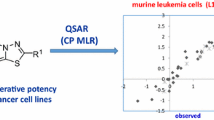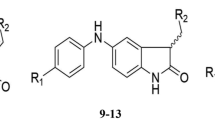Abstract
A method—RASMS (random sampling analysis on molecular surface)—was used to describe the chemical structures of 65 imidazo[4,5-b]pyridine derivatives as anticancer drugs. Here a quantitative structure activity relationship model was built by multiple linear regression (MLR). The estimation stability and prediction ability of the model were strictly analyzed by both internal and external validations. The correlation coefficients of established MLR model, leave-one-out cross-validation, and predicted values versus experimental ones of external samples were r 2 = 0.782, Q 2CV = 0.737, and r 2(test) = 0.775, respectively. These values indicated that the built MLR model had both favorable estimation stability and good prediction capabilities. Furthermore, satisfactory results showed that RASMS could preferably express the information related to the biological activity of imidazo[4,5-b]pyridine derivatives.




Similar content being viewed by others
References
Bababdani BM, Mousavi M (2013) Gravitational search algorithm: a new feature selection method for QSAR study of anticancer potency of imidazo[4,5-b]pyridine derivatives. Chemom Intell Lab Syst 122:1–11
Bolanos-garcia VM (2005) The human genome contains three members the aurora kinase family: aurora A. Int J Biochem Cell B 37:1572–1577
Bondi A (1964) Van der Waals volumes and radii. J Phys Chem 68:441–451
Chan F, Sun C, Perumal M, Nguyen QD, Bavetsias V, McDonald E, Martins V, Wilsher NE, Raynaud FI, Valenti M, Eccles S, Poele RT, Workman P, Aboagye EO, Linardopoulos S (2007) Mechanism of action of the aurora kinase inhibitor CCT129202 and in vivo quantification of biological activity. Mol Cancer Ther 6:3147–3157
Chiang CC, Lin YH, Lin SF, Lai CL, Liu C, Wei WY, Yang SC, Wang RW, Teng LW, Chuang SH, Chang JM, Yuan TT, Lee YS, Chen P, Chi WK, Yang JY, Huang HJ, Liao CB, Huang JJ (2010) Discovery of pyrrole-indoline-2-ones as aurora kinase inhibitors with a different inhibition profile. J Med Chem 53:5929–5941
Crane R, Gadea B, Littlepage L, Wu H, Ruderman JV (2003) Aurora A, meiosis and mitosis. Bio Cell 96:215–229
Giet R, Prigent C (1999) Aurora/Ip11p-related kinases, a new oncogenic family of mitotic serine-threonine kinases. J Cell Sci 122:3591–3601
Hahn M (1995) Receptor surface models. 1 definition and construction. J Med Chem 38:2080–2090
Mitra I, Saha A, Roy K (2010) Exploring quantitative structure–activity relationship studies of antioxidant phenolic compounds obtained from traditional Chinese medicinal plants. Mol Simul 13:1067–1079
Pei JF, Wang Q, Zhou JJ, Lai LH (2004) Estimating protein-ligand binding free energy: atomic solvation parameters for partition coefficient and solvation free energy calculation. Proteins 57:651–664
Roy K, Mitra I (2011) On various metrics used for validation of predictive QSAR models with applications in virtual screening and focused library design. Comb Chem High Throughput Screen 14:450–474
Roy K, Mitra I, Kar S, Ojha PK, Das RN, Kabir H (2012) Comparative studies on some metrics for external validation of QSPR models. J Chem Inf Model 52:396–408
Roy K, Chakraborty P, Mitra I, Ojha PK, Kar S, Das RN (2013) Some case studies on application of ‘‘r 2 m ’’ metrics for quality of quantitative structure–activity relationship predictions: emphasis on scaling of response data. J Comput Chem 34:1071–1082
Siegel B, Ward E, Brawley D (2011) Cancer statistics, 2011: the impact of eliminating socioeconomic and racial disparities on premature cancer deaths. CA Cancer J Clin 61:212–236
Tong JB, Liu SL, Zhou P, Wu BL, Li ZL (2008) A novel descriptor of amino acids and its application in peptide QSAR. J Theor Biol 253:90–97
Tong JB, Chen Y, Liu SL, Che T, Xu XM (2012) A descriptor of amino acids SVWG and its applications in peptide QSAR. J Chemom 26:549–555
Tong JB, Chen Y, Liu SL, Xu XM (2013) QSAR studies of antituberculosis drug using three-dimensional structure descriptors. Med Chem Res 22:4946–4952
Tong JB, Zhong L, Zhao X, Liu SL, Wang P (2014) Quantitative structure–activity relationship studies of diarylpyrimidine derivatives as anti-HIV drugs using new three-dimensional structure descriptors. Med Chem Res 23:1634–1642
World Health Organization Media centre (2012) http://www.who.int/mediacentre/factsheets/fs297/en/. Accessed 12 Feb 2013
Zhou P, Tong JB, Tian FF, Li ZL (2006) A novel comparative molecule/pseudo receptor interaction analysis. Chin Sci Bull 51:1824–1829
Acknowledgments
The authors appreciate the financial support from the National Natural Science Foundation of China (21275094) (21301113), the Scientific Research Planning Program of Key laboratory of Shaanxi Province of China (2011SZS007), and the Graduate Innovation Fund of Shaanxi University of Science and Technology.
Author information
Authors and Affiliations
Corresponding author
Electronic supplementary material
Below is the link to the electronic supplementary material.
Rights and permissions
About this article
Cite this article
Tong, J., Zhao, X. & Zhong, L. QSAR studies of imidazo[4,5-b]pyridine derivatives as anticancer drugs using RASMS method. Med Chem Res 23, 4883–4892 (2014). https://doi.org/10.1007/s00044-014-1045-6
Received:
Accepted:
Published:
Issue Date:
DOI: https://doi.org/10.1007/s00044-014-1045-6




